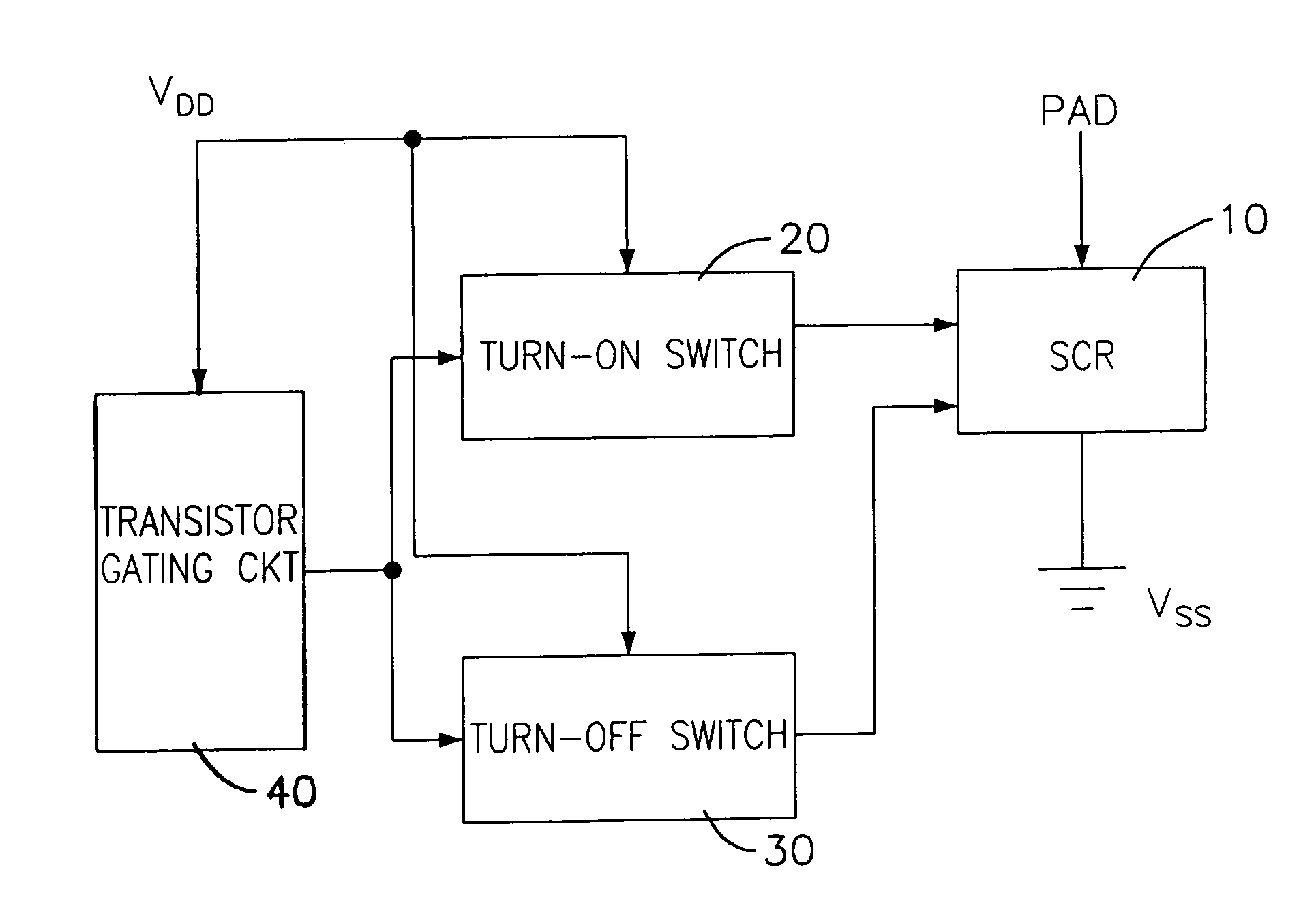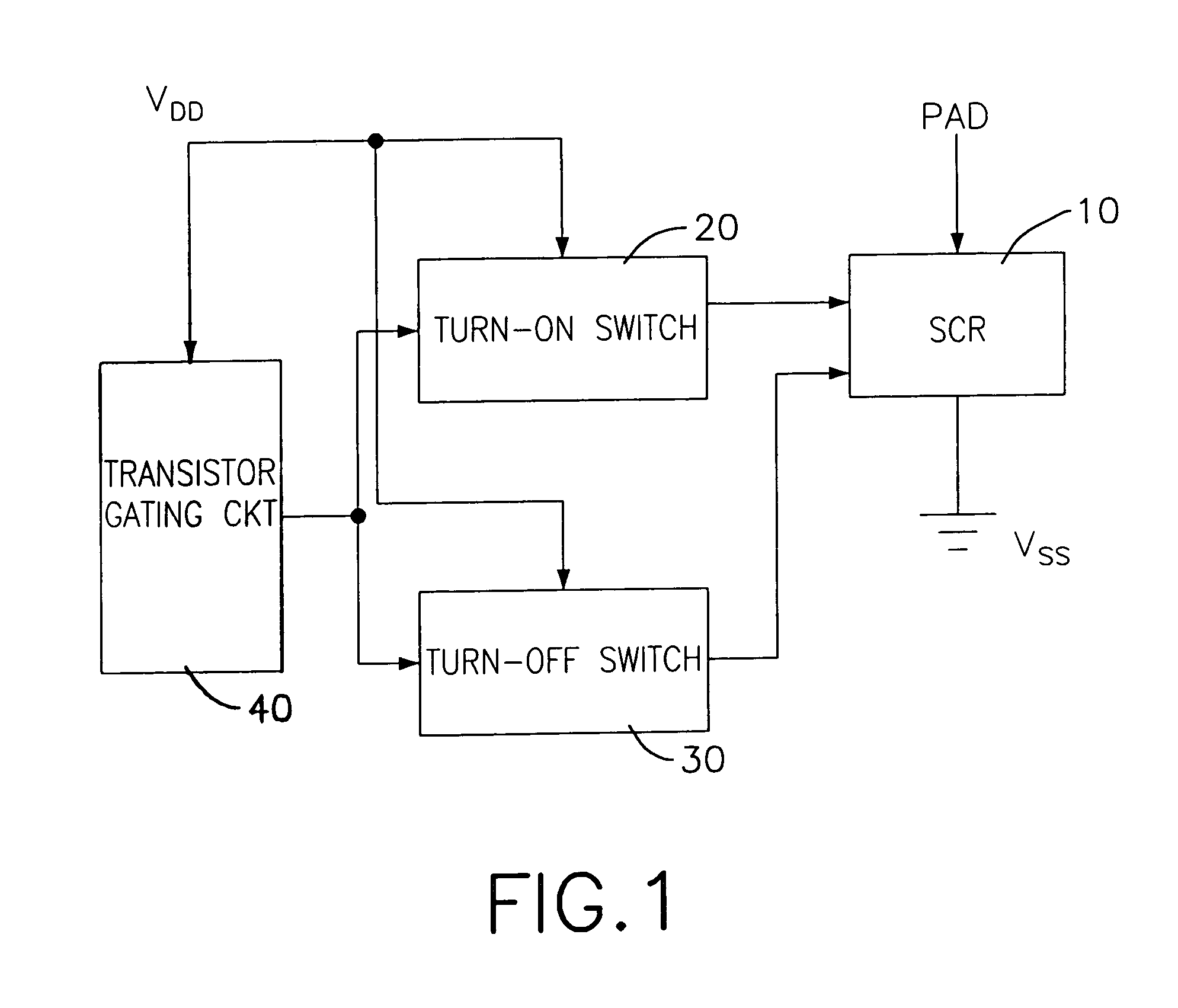Latch-up-free ESD protection circuit using SCR
a protection circuit and esd technology, applied in the direction of emergency protection arrangements for limiting excess voltage/current, pulse manipulation, pulse technique, etc., can solve the problems of high trigger voltage, unsatisfactory electrostatic discharge efficiency, and device damage, etc., to achieve high discharge efficiency, high stability, and fast switching
- Summary
- Abstract
- Description
- Claims
- Application Information
AI Technical Summary
Benefits of technology
Problems solved by technology
Method used
Image
Examples
third embodiment
[0062]The unique feature of the ESD protection circuit shown in FIG. 4 is that the SCR (10) employs a PMOS (13) to replace the diode. This PMOS (13) possesses the same functional characteristics as the diode. When overvoltage stress develops, the PMOS (13) initiates the PNP transistor (11) of the SCR (10). After overvoltage stress is released, the transistor gating circuit (40) sends out a high voltage pulse and a forward voltage is generated to cause the PMOS (13) to be disabled, thus the SCR (10) (that is the PNP transistor) will be switched off. The effect is similar to using the NMOS (31) of the turn-off switch (30) to switch off the PNP transistor of the SCR (10), except that the SCR (10) can be tripped at a faster rate.
[0063]When overvoltage stress develops over the input pad (PAD) in the forward fast-transient mode, the transistor gating circuit (40) sends out a low voltage pulse to cause the PMOS (13) of the turn-on switch (20) to be enabled. Since the voltage drop through t...
fourth embodiment
[0064]In the fourth embodiment, the SCR (10) as shown in FIG. 5, is formed by a PNP transistor (11) and an NPN transistor (12), both being bipolar junction transistors. The emitter of the PNP transistor (11) forms an anode of the SCR (10), and the base through a resistor RN is connected to the anode, and the collector of the PNP transistor (11) is connected to the base of the NPN transistor (12), and through a resistor RSUB is connected to the negative power supply VSS to form a cathode of the SCR (10). The emitter of the NPN transistor (12) is coupled with a diode D1, forming another cathode of the SCR (10). The bases of the PNP transistor and the NPN transistor act as the gate of the SCR (10).
[0065]The turn-on switch (20) is formed by an NMOS (21) and a voltage clamping circuit (22), wherein the drain of the NMOS (21) is connected to the base of the PNP transistor (11) of the SCR (10), and the gate is connected to the transistor gating circuit (40) to enable the SCR (10). The volt...
fifth embodiment
[0073]ESD protection circuit as shown in FIG. 6 employs an NMOS (14) to replace the diode D1 of the SCR (10).
[0074]When forward overvoltage stress develops, the transistor gating circuit (40) produces a high voltage pulse and a forward voltage is generated to cause the NMOS (14) in the turn-on switch (20) to be turned on. The function of the NMOS (14) is similar to that of PMOS (13) shown in FIG. 4, wherein the NMOS (14) is connected to the emitter of the PNP transistor (11). Since the voltage drop through the NMOS (14) is below the trigger voltage of the diode, when the SCR (10) remains in conduction, and the holding voltage is lowered, better protection can be achieved in electrostatic discharge.
[0075]According to the present invention, the SCR (10) is able to provide effective ESD protection, irrespective whether the overvoltage stress is developed in the fast-transient or quasi-static mode.
[0076]In conclusion, the present invention provides a technique to trigger an SCR into con...
PUM
 Login to View More
Login to View More Abstract
Description
Claims
Application Information
 Login to View More
Login to View More - R&D
- Intellectual Property
- Life Sciences
- Materials
- Tech Scout
- Unparalleled Data Quality
- Higher Quality Content
- 60% Fewer Hallucinations
Browse by: Latest US Patents, China's latest patents, Technical Efficacy Thesaurus, Application Domain, Technology Topic, Popular Technical Reports.
© 2025 PatSnap. All rights reserved.Legal|Privacy policy|Modern Slavery Act Transparency Statement|Sitemap|About US| Contact US: help@patsnap.com



